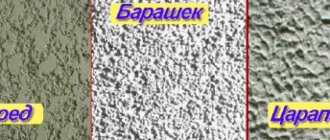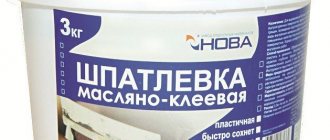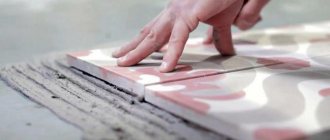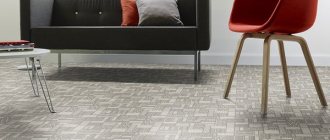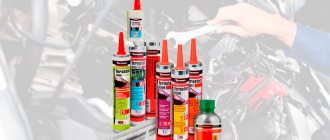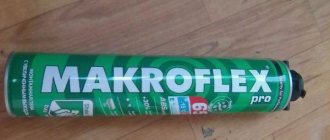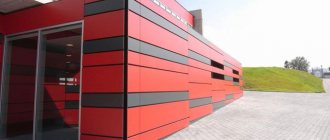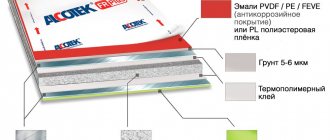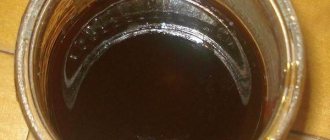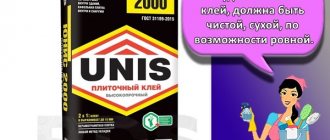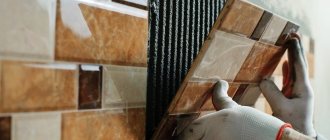Characteristics of Ceresit products
To eliminate deviations on the wall surface, there are solutions ST 24 and ST 29.
Optimal conditions for their use:
- the surface and ambient air temperature should be 5-30°;
- the base should not be heated by direct rays of the sun;
- the weather outside should be without precipitation or wind;
- the surface must be cleaned of dirt and grease;
- treat the surface with ST 17 primer mixture.
Plaster for leveling walls
The procedure for working with compositions is as follows:
- add dry material to water at a temperature of 15-20° according to the instructions and mix with a mixer;
- apply the solution to the base with a wide spatula;
- after 10-20 minutes, smooth the layer with a plastic trowel;
- after 3 days you can continue finishing work;
- After a week you can paint the surface.
Ceresit ST 24 is applied in a layer 3-30 mm thick, Ceresit ST 29 - 2-20 mm.
There are decorative ceresit plasters. These are: Dekor Plus, ST 35, ST 137. Before using them, it is recommended to treat the base with ST 16 or ST 17 primer. Ready-made plaster solutions are applied to the walls, creating textures: “fur coat”, “pebble” and “bark beetle”. Different furrows are created using pebbles of different sizes that are part of the “bark beetle”. A “fur coat” is obtained by passing a short-haired roller over fresh mortar. You can paint the finished surface after 3 days (with silicate dyes) and after a week (with silicone paints). Dekor Plus is suitable for such work.
Decorative plaster
Composition ST 35 is intended for any coating. When using the “winter” modification, there is no need to prime the base.
ST 137 is designed to create a grainy texture on the surface.
ST 63 is an acrylic-based decorative plaster. It contains pebbles that give structure to the surface. The ST 64 composition also contains pebbles, but their sizes are smaller, not exceeding 2 mm. In all other respects the compositions are exactly the same.
ST 72 is a ready-to-use plaster. It can become a base for tinting. The plaster layer is resistant to mold and has great durability. It can be applied in rooms with high humidity, outdoors. This decorative plaster is available in different grain sizes. The composition is very easy to use.
ST 73 is a plaster with a grain size of 2 mm. With its help you can create a “bark beetle” texture.
Finished plaster
ST 77 has 12 different colors, the number of fractions is 4. The binder composition is acrylic.
Using silicone-silicate plaster ST 174, a “pebble” structure is created. The grains have sizes of 1.5 and 2 mm.
ST 175 - plaster for creating a “bark beetle” texture. The product is ready for use. It can be tinted at the request of the consumer.
Mostly plaster is produced in bags of 25 kg.
Customer Reviews
Vladimir Kuznetsov
I used decorative plaster Ceresit CT 137 to decorate the hallway at the dacha. This was my first time working with this material. When applied, the plaster does not form into lumps and does not flow. Overall the material is decent. As for texture, creating a pattern is relatively simple. True, it still hardens a little longer than stated on the packaging.
Leonid Vengrin
I have known this brand for quite a long time. When insulating a house, Ceresit was one of the first to provide plasters for finishing. I used ST 35 mineral decorative plaster. On the website, everything was clearly described on how to prepare the mixture, apply it, and add texture. It has lasted for three years now, does not peel off, does not crack. Overall satisfied.
Tools and materials for work
To work with Ceresit materials you may need:
- plastic and steel grater;
- grater;
- putty knife;
- level;
- falcon;
- plaster trowel;
- hatchet;
- scoop;
- plaster trowel;
- corner leveler;
- ironer;
- plaster spatula;
- rule.
Necessary tools for applying plaster
Materials you will need:
- insulation material;
- glue;
- reinforcing mesh;
- dowels with wide caps;
- waterproofing material;
- putty;
- primer composition;
- base profile;
- facade paint;
- brush.
Where is Ceresit glue used?
Dry building mixtures from this company are used for various types of surfaces. The choice of mixtures is incredibly huge, each of them has its own purpose.
- CM. Mixtures for gluing different types of tiles;
- NE. Adhesive for partial repair of coated surfaces;
- ST. Adhesive for installing thermal insulation material.
Facade plaster Ceresit
Factories for the production of decorative plaster Ceresit are located in many countries, including Russia, which indicates the demand for the material and, accordingly, the high quality of the products. In addition, the technology for producing facade mixtures is slightly different from analogues.
Ceresite consists of high-tech constituent substances that provide the material with appropriate qualities. A large range of products will help you decide on the choice of material. The material is presented by the manufacturer in different texture options, with different compositions (depending on the purpose).
Variety of colors and textures
Advantages
C eresit is widespread precisely because of its positive characteristics:
- high elasticity (the material contains components that enhance the elasticity and viscosity of the material);
- ease of application (standard application with a spatula does not differ from similar work with other mixtures);
- creates an impact-resistant coating (mechanical stability guaranteed by the manufacturer);
- resistance to fading (even the colored mixture does not fade when exposed to ultraviolet rays);
- the material is durable (performance properties last for more than 30 years);
- environmental friendliness (plaster does not contain harmful substances);
- moisture resistance (the coating repels water and prevents its penetration into the surface);
- resistance to pollution;
- resistance to temperature changes;
- variety of colors and shades.
In addition, the material has good adhesive properties, which allows it to be used on different surfaces. Classification according to use in cold and warm seasons also helps with selection, especially when performing work in the cold season.
Flaws
No technical shortcomings were found in this mixture: the material has established itself as a quality product. If we can call the high price (compared to analogues) a disadvantage, then this is the only thing that does not always suit the buyer. The price is consistent with the quality, so if you pay a little more, you can feel complete satisfaction from the quality of the product.
Grout consumption
Below is a summary table of the consumption of all Ceresit grouts (approximate consumption of the dry mixture per square of cladding):
Tile size, cm Joint width, mm Joint depth, mm CE consumption 33, kg/m2 CE consumption 35, kg/m2 CE consumption 40, kg/m2 CE consumption 43, kg/m2
| 5*5 | 2 | 0,5 | 0,5 | |
| 5*5 | 3 | 0,7 | 0,7 | |
| 10*10 | 2 | 0,4 | 0,4 | |
| 10*10 | 3 | 0,4 | 0,4 | |
| 15*15 | 3 | 0,4 | 0,4 | |
| 20*20 | 5 | 0,5 | 0,4 | 0,5 |
| 25*25 | 8 | 0,8 | ||
| 30*30 | 10 | 1,0 | ||
| 40*40 | 12 | 1,0 | ||
| 50*50 | 12 | 1,2 | ||
| 60*60 | 5 | 8 | 0,2 | |
| 40*40 | 5 | 8 | 0,3 | |
| 24*6 | 5 | 8 | 1,0 | |
| 24*6 | 10 | 8 | 1,9 | |
| 40*20 | 10 | 15 | 1,4 | |
| 40*20 | 20 | 20 | 3,6 | |
| 50*20 | 20 | 30 | 5,0 |
The consumption of two-component grout CE 79 will depend on its application. If you use it to fasten tiles, then the approximate consumption will be as follows:
Tile length, cm Size of trowel teeth, mm Consumption CE 79, kg/m2
| <5 | 3 | 1,9 |
| <10 | 4 | 2,2 |
| <15 | 6 | 2,8 |
| <25 | 8 | 3,4 |
If you are using this epoxy grout to fill cladding joints:
Tile size, cmTile thickness, cmSeam width, mmConsumption, kg/m2
| 5*5 | 5 | 4 | 1,3 |
| 10*10 | 8 | 4 | 1,0 |
| 15*15 | 6 | 6 | 0,8 |
| 10*20 | 6 | 6 | 0,9 |
| 10*20 | 10 | 8 | 1,9 |
| 20*20 | 10 | 8 | 1,3 |
| Forum for calculating the consumption of CE 79 mixture: Consumption (kg/m2) = total length of joints (m) * depth of joints (m) * width of joints (m) * 1.6 (kg/dm2) |
Approximate consumption of silicone grout-sealant CS25:
Seam size in section, mmConsumption, ml/linear meter of seam
| 5*5 | 25 |
| 10*5 | 50 |
| 10*10 | 100 |
| 15*10 | 150 |
Types of Ceresit plaster
High-quality Ceresit coatings are classified according to their composition:
- silicone. Designed for finishing. The composition prevents the appearance of fungi, masks small cracks, and is suitable for use in expensive mixtures;
- acrylic. They are able to hide defects on the surface, are not vapor-tight, have a smooth texture, and have increased strength indicators;
- cement. Due to the presence of cement in the mixture, this coating is durable, breathable, elastic, and easy to apply;
- silicate. The main component of the mixture is silicate resin. These mixtures are elastic, especially durable, and are most often used for interior work (in rooms with high humidity), as well as for exterior work;
- mineral. Used for external coating of facades.
In addition, Ceresit compositions are made for subsequent painting or for finishing coating without painting.
Facade mixtures are divided into “winter” (they can be worked with at temperatures below 0°C) and “summer” (for work in hot weather).
Color palette
The color palette of Ceresit grout mixtures is very rich and varied. There are 31 primary colors, about 57 additional shades. Such advantages distinguish this brand in the market.
The main colors of the ceresite mixture are shown in the table:
When purchasing, you need to take into account the rules for selecting colors and shades:
- The light colors of the ceresite grouting material help to visually enlarge the room and unify the tiled pattern.
- Dark shades bring specificity to each tile, making it stand out from the general background. At the same time, the color of the tile and the texture of the cladding are emphasized.
- If there are decorative inserts, then the mass of the general background should be combined with them, while the grout should differ by no more than 2 tones.
- If the tile contains a variety of patterns and decor, then the grout should be chosen transparent.
- The flooring often gets dirty and the light-colored putty will lose its appearance, so it is preferable to buy putty in dark shades.
- The cladding will become more expressive with a contrasting combination of tiles and joints.
- To create a luxurious design, a metallic shade of seams is suitable.
When choosing a Ceresit color, you need to make sure that it is suitable for the design of not only the facing part, but also for the entire room.
Installation of thermal insulation boards.
If the façade needs insulation, install thermal insulation boards. You can use hard mineral wool or polystyrene foam.
It is recommended to use ST 84 polyurethane adhesive or Ceresit ST brand compositions (85 or 190) as an adhesive mixture.
How to apply the adhesive mixture correctly:
- on mineral wool slabs - over the entire surface, in a continuous, thin layer;
- slabs of expanded polystyrene are coated with glue around the perimeter, retreating 2 cm from the edge, and the width of the strip should be 6 cm, and the thickness - 2 cm. The glue is applied to the rest of the surface of the slab in patches of the same thickness, with a diameter of 10 cm. It is enough to apply to one slab from 5 to 8 “patch”.
As soon as the glue is applied, immediately attach the slab to the wall and press down so that it fits well over the entire surface.
Coat and lay the remaining slabs in the same way. First lay the first horizontal row, starting from the base, checking that the surface does not deviate from the vertical. Then lay the remaining slabs in order.
When the process is complete, wait for the glue to dry, then sand the surface with coarse sandpaper, securing it to a holder for convenience. A special manual machine is suitable for this work. For reliability, reinforce the slabs with disc dowels.
Important! If you start sanding the slabs immediately after installation, while the glue is still wet, they may move.
Mixture finishing technology
Before applying the ceresit mixture, you need to prepare the surface:
- Thorough cleaning of dirt and dust is carried out.
- Defects are leveled out (mixtures of Art. 24, Art. 29 are applicable - depending on the base).
- The joint from the façade plane to the foundation is covered with a plinth profile.
- Application of a reinforcing layer: the waterproofing mixture is applied with a thickness of 2–3 mm; a mesh is applied and pressed (buried) into the mixture; a second layer is applied on top of the mesh; wait until it dries completely.
- The dried surface is primed.
- The plaster mass is applied: application is done with a trowel; the thickness of the layer must correspond to the size of the grain in the mixture; the texture is done with a polyurethane float after the layer has stopped sticking.
You can paint with silicate masses after three days, with silicone after 7 days.
To create the same shade, the entire surface is covered with a plaster compound produced in one batch.
Useful video on the topic:
What is pebble plaster?
To create a surface with a shallow relief, pebble plaster Ceresit ST 77 series with the required grain size is used. This is an aqueous solution made on the basis of silicate and silicone polymers, to which coloring pigments, mineral fillers and marble chips are added. This plaster is available in several versions, including “Winter” - for use in the cold season.
Application area.
Pebble plaster is used to create a thin-layer decorative coating on external and internal walls and architectural elements. The finish is similar in appearance to stone chips, it is not damaged by fungus and mold, does not crumble, is resistant to moisture, but allows air to pass through well, i.e. the walls “breathe”. The coating can be painted. This mixture can be used to plaster concrete, drywall, gypsum, cement-sand bases, chipboard, putty and plastered surfaces.
Important! You should work with latex gloves and safety glasses. Mix plaster only in stainless steel containers. If work was carried out inside, the room must be well ventilated.
When finishing the walls outside, choose the time so that the applied mixture dries without being exposed to direct sunlight, precipitation, or dampness.
Scope of application
Each Ceresit tile adhesive has its own areas of use. In particular, CM 9 Plus is best suited for small ceramic slabs on non-deforming substrates. CT 84 as a polyurethane adhesive is suitable for polystyrene foam and other mineral substrates.
Ceresit CM 11 tile adhesive is indicated for ceramics when carrying out external and internal cladding work. CM 14 Extra is available for porcelain tiles and ceramics. Ceresit CM 17 adhesive is produced for those cases where increased elasticity is important. CM 16 works best for fixing any type of slabs inside and outside the yard. Ceresit CM 117 adhesive is most often used for facade tiles.
The most common representative, Ceresit CM 11, is used for the following coatings:
- Ceramics, porcelain stoneware, clinker, piece and natural stone.
- Parapets, stairs, floors, terraces, roofing.
- Anhydrite coatings, gypsum.
- Young concrete.
- Deformable coatings (with the addition of elasticizers).
- Swimming pools and large water tanks.
CM 11 is excellent in conditions of regular exposure to moisture and liquids. It is used for cladding with a water absorption of 3% and a size of no more than 30x30.
Reference! For deformable surfaces, it is best to use Ceresit CM 17 or CM 11, but only when combined with the elasticizer CC 83.
Classification of plasters
The well-known Henkel concern is famous for its high quality products and the variety of materials presented in its catalogs. Series of plasters produced by a well-known manufacturer include all popular types from different price categories:
- Elite silicone modifications, which are supplied in a special sealed container. Their purpose is a thin-layer finishing finish. This type combines vapor permeability and immunity to the development of fungi. The silicone base is elastic, masks small cracks when applied, and is stable in use. Belongs to a fairly high price category.
- Acrylic compounds form a thin, smooth or textured surface and hide minor defects. But they do not have special vapor permeability. A full-color palette will add a special flavor to any room or building facade. Sold in closed plastic containers.
- Silicate pastes are durable and flexible. They are intended for decorating external walls, as well as rooms with an unstable microclimate - for example, loggias, bathrooms, kitchens and storage rooms.
- Cement-based compositions are affordable and reliable. Presented in the form of dry mixtures of prepared cement and sifted sand or white cement with purified lime. Suitable for both interior and facade work.
Surface preparation
The surface must be clean and free of grease before using Ceresit glue. First, the base is cleaned of dirt, paints, fats and oils. If there are significant defects, they are repaired, then the surface is leveled.
Small holes can be leveled with CM 11. When there are significant unevennesses, a day before work you need to use composition SN 72 or SN 83.
Typical bases
Ceramic tiles can be applied to cement and plaster without pre-treatment. Dry surfaces require moisture. In this case, the cement foundation must be equipped at least 28 days before work, and the concrete one - six months before.
On video: Ceresit tile adhesive.
Atypical
Various particle boards and anhydrite bases, gypsum, cellular concrete must first be primed, for which Ceresit ST 17 is suitable. After this, at least 5 hours should pass. Substrates coated with water-dispersed paints with high adhesion, plasterboard panels, bituminous materials, and drywall do not require a primer.
Brands of material and the advisability of their use
Ceresite is distinguished by a special variety of compositions. To choose the right mixture, you should think through the work in advance and imagine the final result.
The universal version Cerecit Dekor Plus goes on sale in powder form. Excellent insulating properties, impact resistance, resistance to temperature changes, long-term exposure to heat or cold allow this type to be used both for facades and interior work. The project is produced in different textures: “bark beetle”, “fur coat”, and other decorative varieties with pebble inclusions are available to a wide range of buyers. The dried surface can be perfectly tinted with silicate or acrylic paints.
Decorative grade CT 72/CT 73 is produced in a ready-to-use solution, but is subject to subsequent painting. Indispensable for interior work.
To quickly eliminate cracks and chips, craftsmen choose ceresit CH 83. The mixture can be applied in a fairly thick layer: up to 30 mm per pass. It is better to entrust the leveling of any bases for the upcoming finishing to the ST 29 brand - this type will perfectly “cope” with smaller defects of walls and ceilings.
Ceresit CT 77 has a wide color palette. Used as facade finishing or covering for problem areas - for example, with high humidity.
The ST 35 variation is considered thin-layer and is available in two types with granule inclusions of 2.5 or 3.5 mm. You can purchase a white version or a colored one.
Pebble decorative fine-grained plaster ST 137 forms a surface in the form of densely spaced structural inclusions. Involves finishing coloring.
Mosaic queen ST 77 has a palette of 38 colors. It is used as a façade finish because it adheres well to any building material. The polymer coating is wear-resistant and impervious to atmospheric changes, inert to precipitation of any kind. This option can also be used as an interior option.
Price
The cost of Ceresit CE 40 grout is 370-590 rubles. It all depends on the packaging, the chosen color and the offer of a particular store.
But this information will help you understand where you can use epoxy grout for litokol tiles.
What is the price of grouting tiles in the bathroom and which one should be used and what name will help you understand the content in this article.
It will also be interesting to know how long it takes for bathroom tile grout to dry.
But this information will help you understand how to use moisture-resistant grout for tile joints in the bathroom and what is the consumption of this material when used.
Working with Ceresit plaster
The principles of finishing walls with different types of plasters from a German manufacturer are close to the general rules for working with similar materials. Beginners are advised to study the attached instructions and try applying the compositions on a rough surface. This will give you the opportunity to “feel” the solution.
Facade and interior finishing begins only after cleaning the working surface from the old coating, degreasing the wall and applying a layer of primer. Textured types of ceresit plaster do not require a perfectly flat original wall, since they perfectly mask individual non-global defects. If there are significant cracks, you should first use mixtures based on cement or gypsum.
To ensure that the decorative coating does not differ in structure and tone, it is wiser to immediately purchase the required quantity of goods from one batch. And for each wall you should make a separate batch or use the entire solution on the day of preparation - this recommendation does not apply to ready-made compositions in sealed containers.
The thickness of each layer should not normally exceed the size of the structural inclusion by 1.5 times. The texture is formed only after the solution dries and stops sticking to the hand or tool. Typically, simple patterns are created using multidirectional movements with light pressure with a plastic or wooden grater. For example, with a circular swing you will get the popular “lamb”.
Experts recommend choosing components for multi-stage work from the line of one manufacturer. If the priority is decorative plaster of the Ceresit brand, then other consumables should be selected from this series, since they remain the most compatible.
Therefore, professionals often give preference to the European quality of Henkel products: in the list of products produced by the concern, you can find everything you need for design and finishing work.
How to properly prepare the mixture
To prepare the mass for work you will need: a container of a certain volume (stainless steel), purified water, a concrete mixer, a mixer or a drill with an attachment.
When diluting the mass, the proportions indicated on the back of the package are strictly observed. On average, a 25 kg bag requires 5–6 liters of water. After mixing, the mass is left for three minutes to completely dissolve and mixed again.
The finished mixture should be consumed within three hours. If the mass is frozen, then it cannot be used. Repeated dilution with water is prohibited.
